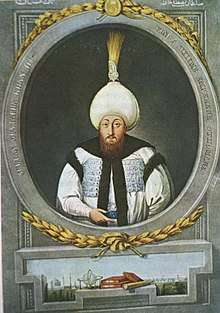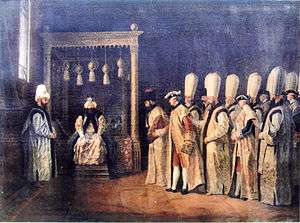Mustafa III
| Mustafa III مصطفى ثالث | |||||
|---|---|---|---|---|---|
|
Caliph of Islam Amir al-Mu'minin Sultan of the Ottoman Empire Kayser-i Rûm Custodian of the Two Holy Mosques | |||||
 | |||||
| 26th Ottoman Sultan (Emperor) | |||||
| Reign | 30 October 1757 – 24 December 1773 | ||||
| Predecessor | Osman III | ||||
| Successor | Abdul Hamid I | ||||
| Born |
28 January 1717 Topkapı Palace, Istanbul, Ottoman Empire | ||||
| Died |
24 December 1773 (aged 56) Topkapı Palace, Istanbul, Ottoman Empire | ||||
| Burial | Fatih, Istanbul | ||||
| Consorts |
Mihrişah Sultan Aynülhayat Kadın Adilşah Kadın Rif’at Kadın one another wife | ||||
| Issue | see below | ||||
| |||||
| Dynasty | Ottoman | ||||
| Father | Ahmed III | ||||
| Mother | Mihrişah Kadın | ||||
| Religion | Sunni Islam | ||||
| Tughra |
| ||||

-8478.jpg)
-8477.jpg)
Mustafa III (Ottoman Turkish: مصطفى ثالث, lit. 'Muṣṭafā-yi sālis') (28 January 1717 – 24 December 1773) was the Sultan of the Ottoman Empire from 1757 to 1773. He was a son of Sultan Ahmed III (1703–30) and was succeeded by his brother Abdul Hamid I (1774–89). He was born in Edirne Palace. His mother was Mihrişah Kadın.
Early life
Mustafa was born at the Edirne Palace on 28 January 1717.[1] His mother was Mihrişah Kadın.[2] He had a full brother named, Şehzade Süleyman. In 1720, a large fifteen days circumcision ceremony took place for Mustafa, and his brothers, princes Süleyman, Mehmed, and Bayezid.[3]
Reign
Mustafa ascended the throne on 30 October 1757, after the death of his cousin Osman III, the son of Sultan Mustafa II.[4]
Character of Mustafa's rule
Soon after his accession to the throne, Mustafa demonstrated a special care for justice. He took a number of measures to increase prosperity in Istanbul. He regulated coinage, built large grain stores, maintained aqueducts, and established a strict fiscal policy.[5]
Treaty with Prussia
Mustafa much admired the Frederick the Great's generalship, and in 1761 established a peace treaty with Prussia. Frederick wanted an alliance against the Hasburgians, and Mustafa wanted to modernize his state and army. Mustafa preferred recruiting his officers in Berlin, rather than in Paris and London, to re-organize his army. In 1763, the two countries exchanged their diplomats for the first time.[6]
Russo-Turkish War (1768–1774)
Koca Ragıp Pasha, who remained grand vizier until 1763, pursued a peace policy towards neighboring countries. But the increasing influence of Russia over the Caucasus and its intention to control Poland created tension between the Ottomans and Russia. Ragıp Pasha's successor Muhsinzade Mehmed Pasha also preferred to remain at peace, and Mustafa's insistence on war with Russia led to his resignation in 1768. The Sultan expected to gain an easy victory over the Russians, but in fact the Ottomans were unprepared for a long war. During the war, military reforms were undertaken, with the assistance of French officer François Baron de Tott. They included the modernization of artillery corps and the foundation of the Naval Engineering School in 1773. The war was disastrous for the Ottoman Empire. The Russian armies occupied the Crimea, Romania and parts of Bulgaria.[7]
Architecture
Many monumental buildings including the Fatih Mosque, which was built by Mehmed the Conqueror was rebuilt from the ground during his reign. In addition, he had built Laleli Mosque complex, and the shore along the Yenikapı filled to set up a new neighborhood. Apart from these, he undertook other construction projects after the earthquakes of 1766-67.[5]
Personal life
Poetry
He was an excellent poet, his poetry being written under the pseudonym of Cihangir.[8]
(Ottoman Turkish)
“Yıkılupdur bu cihan sanma ki bizde düzele
Devleti çarh-ı deni verdi kamu müptezele
Şimdi erbab-ı saadette gezen hep hazele
İşimiz kaldı hemen merhamet-i lem yezele.”[9]
(Translation)
"This world has ruined, don't even think with us it recovers,
It was the lousy fate that has delivered the power to vulgars,
Now the perfidious ones have populated the Imperial Palace,
It's now the mercy of the everlasting God that runs our business.
Family
- Consorts
- First consort name unknown;[10]
- Mihrişah Sultan (died 16 October 1805, buried Mihrişah Sultan Mausoleum, Eyüp, Istanbul);[11]
- Aynülhayat Kadın (died 21 July 1764, buried in Mustafa III Mausoleum, Laleli Mosque, Istanbul);[12]
- Adilşah Kadın (died 19 December 1803, buried in Mustafa III Mausoleum, Laleli Mosque, Istanbul);[13]
- Rifat Kadın (died 25 December 1804, buried in Haydarpaşa Cemetery, Istanbul);[14][15]
- Sons
- Selim III (24 December 1762 – 28 July 1808, buried in Mustafa III Mausoleum), with Mihrişah;
- Şehzade Sultan Mehmed (10 January 1767 – 12 October 1772, buried in Mustafa III Mausoleum, Laleli Mosque Istanbul), with Mihrişah;
- Daughters
- Hibetullah Sultan (14 March 1759 – 7 June 1762, buried in Mustafa III Mausoleum, Laleli Mosque, Istanbul), with Mihrişah;[16]
- Şah Sultan (20 April 1761 – 11 March 1803, buried in Şah Sultan Mausoleum, Eyüp, Istanbul), with Mihrişah, married firstly on 23 April 1764 to Damad Köse Bahir Mustafa Pasha, Grand Vizier, married secondly on 1 January 1768 to Damad Mehmed Emin Pasha, Grand Vizier 1768-1769, married thirdly on 2 October 1778, Damad Seyyid Mustafa Pasha;[17]
- Mihrimah Sultan (5 February 1762 – 6 October 1762, buried in Mustafa III Mausoleum, Laleli Mosque, Istanbul), with Aynülhayat;[18]
- Mihrişah Sultan (9 January 1763 – 21 February 1769, buried in Mustafa III Mausoleum, Laleli Mosque, Istanbul);[19]
- Beyhan Sultan (13 January 1765 – 7 November 1824, buried in Mihrişah Sultan Mausoleum, Eyüp, Istanbul), with Adilşah, married on 22 April 1784 to Damad Celik Mustafa Pasha;[20]
- Hatice Sultan (15 June 1766 – 17 July 1821, buried in Mihrişah Sultan Mausoleum, Eyüp, Istanbul), with Adilşah, married on 10 November 1786 to Damad Seyyid Ahmed Pasha;[21]
- Fatma Sultan (9 January 1770 – 26 May 1772, buried in Mustafa III Mausoleum, Laleli Mosque, Istanbul).
Death
Mustafa died of heart attack[22] on 24 December 1773,[23][24] at the Topkapı Palace, and was buried in own mausoleum located at Laleli Mosque, Istanbul.[25] He was succeeded by his brother Abdul Hamid I.[26] His death left the empire struggling with economic and administrative problems.[27]
References
- ↑ Brill, E. J. The Encyclopaedia of Islām: A Dictionary of the Geography, Ethnography and Biography of the Muhammadan Peoples, Volume 3, Part 2. p. 761.
- ↑ Faroqhi, Suraiya (November 29, 2005). Subjects of the Sultan: Culture and Daily Life in the Ottoman Empire. I. B. Tauris. p. 326. ISBN 978-1-850-43760-4.
- ↑ Murphy, Rhoads (October 20, 2011). Exploring Ottoman Sovereignty: Tradition, Image and Practice in the Ottoman Imperial Household, 1400-1800. A&C Black. p. 182. ISBN 978-1-441-10251-5.
- ↑ Biographical Encyclopaedia of Islam, Volume 3. Cosmo Publications. 2006. p. 864. ISBN 978-8-130-70390-9.
- 1 2 Ágoston 2009, p. 411.
- ↑ Hermann, Rainer (June 16, 2014). Where is Turkey Headed?: Culture Battles in Turkey. Blue Dome Press. ISBN 978-1-935-29572-3.
- ↑ Somel, Selcuk Aksin (March 23, 2010). The A to Z of the Ottoman Empire. Scarecrow Press. p. 203. ISBN 978-1-461-73176-4.
- ↑ Lord Kinross, Ottoman Centuries, (Perennial, 2002), 406.
- ↑ Yıkılupdur bu cihan sanma ki biz de düzele
- ↑ Ateş, Ahmed; Banarlı, Nihad Sâmi (1958). İstanbul Enstitüsü dergisi - Volumes 4-5. Istanbul Enstitüsü. p. 211.
- ↑ Uluçay 2011, p. 150-1.
- ↑ Uluçay 2011, p. 150.
- ↑ Uluçay 2011, p. 149-50.
- ↑ Uluçay 2011, p. 151.
- ↑ Tarih ve toplum: aylık ansiklopedik dergi - Volume 24. İletişim Yayınları/Perka A. Ş. p. 59.
- ↑ Uluçay 2011, p. 151-2.
- ↑ Uluçay 2011, p. 153-4.
- ↑ Uluçay 2011, p. 152-3.
- ↑ Uluçay 2011, p. 153.
- ↑ Uluçay 2011, p. 155-7.
- ↑ Uluçay 2011, p. 157-8.
- ↑ Palmer, Alan (May 19, 2011). The Decline and Fall of the Ottoman Empire. Faber & Faber. ISBN 978-0-571-27908-1.
- ↑ Alexander, John T. (November 9, 1989). Catherine the Great: Life and Legend. Oxford University Press. p. 139. ISBN 978-0-199-87430-9.
- ↑ THE BIOGRAPHICAL DICTIONARY OF THE SOCITEY FOR THE DIFFUSION OF USEFUL KNOWLEDGE VOL. 1 PART II. 1842. p. 523.
- ↑ Ayliffe, Rosie (2003). Turkey. Rough Guides. p. 147. ISBN 978-1-843-53071-8.
- ↑ Hill, George (September 23, 2010). A History of Cyprus, Volume 4. Cambridge University Press. pp. 94 n. 1. ISBN 978-1-108-02065-7.
- ↑ Ágoston 2009, p. 412.
Bibliography
- Uluçay, Mustafa Çağatay (2011). Padişahların kadınları ve kızları. Ankara, Ötüken.
- A ́goston, Ga ́bor; Masters, Bruce Alan (May 21, 2010). Encyclopedia of the Ottoman Empire. Infobase Publishing. ISBN 978-1-438-11025-7.
| Wikimedia Commons has media related to Mustafa III. |
Mustafa III Born: 28 January 1717 Died: 21 January 1774[aged 57] | ||
| Regnal titles | ||
|---|---|---|
| Preceded by Osman III |
Sultan of the Ottoman Empire 30 Oct 1757 – 21 Jan 1774 |
Succeeded by Abdul Hamid I |
| Sunni Islam titles | ||
| Preceded by Osman III |
Caliph of Islam 30 Oct 1757 – 21 Jan 1774 |
Succeeded by Abdul Hamid I |
